
To calculate: The rate of crossover for two projects.
Introduction:
The
Answer to Problem 13QP
The crossover rate for the two projects is 10.19%. The NPV profiles show that both the projects have a higher NPV for the rate of discount below 10.19% and have a lower NPV for the rate of discount above 10.19%.
Explanation of Solution
Given information:
The details of two projects are provided. The project X cash that flows for year 1, year 2, and year 3, are $10,620, $10,900, and $10,500 respectively. The initial investment is $24,000. The project Y cash that flows for 4 years are $12,100, $9,360, $10,400 respectively and the initial investment is $24,000.
Note:
- NPV is the difference between the present values of the cash inflows from the present value of cash outflows.
- The IRR is the rate of interest, which makes the project’s NPV equal to zero. Hence, when using the available information, assume that the NPV is equal to zero and forms an equation to compute the IRR.
Equation of NPV to compute IRR by assuming that NPV is equal to zero is as follows:
Compute IRR for the project X using a spreadsheet:
Step 1:

- Type the equation of NPV in H6 of the spreadsheet and consider the IRR value as H7.
Step 2:

- Assume the IRR value as 10%.
Step 3:

- In the spreadsheet, go to data and select the what-if-analysis.
- In what-if-analysis, select goal seek.
- In a set cell, select H6 (the Formula).
- The “To value” is considered as 0 (the assumption value for NPV).
- The H7 cell is selected for the 'by changing the cell'.
Step 4:
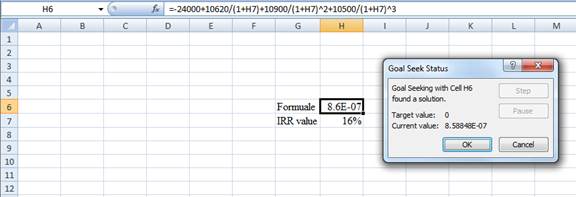
- Following the previous step click OK in the goal seek. The goal seek status appears with the IRR value
Step 5:
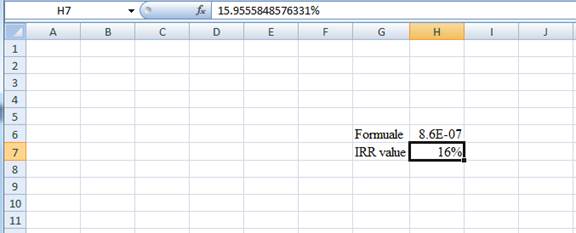
- The value appears to be 15.9555848576331%
Hence, the IRR value is 15.96%.
Compute the IRR for project Y using a spreadsheet:
Step 1:

- Type the equation of NPV in H6 of the spreadsheet and consider the IRR value as H7.
Step 2:

- Assume the IRR value as 10%.
Step 3:

- In the spreadsheet, go to data and select the what-if-analysis.
- In what-if-analysis, select goal seek.
- In a set cell, select H6 (the Formula).
- The “To value” is considered as 0 (the assumption value for NPV).
- The H7 cell is selected for the 'by changing the cell'.
Step 4:
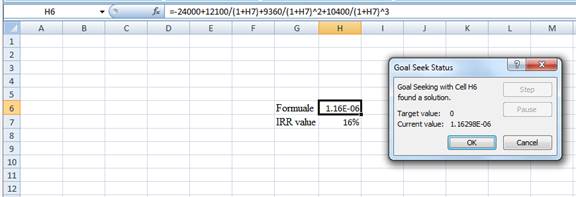
- Following the previous step click OK in the goal seek. The goal seek status appears with the IRR value.
Step 5:

- The value appears to be 16.1307523542427%.
Hence, the IRR value is 16.13%.
Formula to compute the crossover rate is as follows:
Equation of the crossover rate to compute R is as follows:
Where,
“R” denotes crossover rate.
Compute R by using a spreadsheet:
Step 1:

- Type the equation of NPV in H6 of the spreadsheet and consider the IRR value as H7.
Step 2:

- Assume the IRR value as 10%.
Step 3:
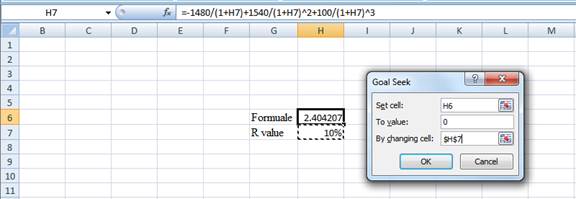
- In the spreadsheet, go to data and select the whatif analysis.
- In what-if analysis select goal seek
- In set cell select H6 (the Formula)
- The “To value” is considered as 0 (the assumption value for NPV)
- The H7 cell is selected for the by changing cell
Step 4:

- Following the previous step click OK in the goal seek. The goal seek status appears with the IRR value.
Step 5:
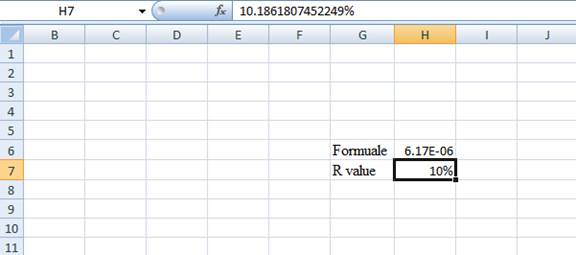
- The value appears to be 10.1861807452249%
Hence, the R-value is 10.19%.
Formula to calculate the NPV is as follows:
Note: As the discount rate is over a range of 0% to 25%, calculate NPV for 0%, 5%, 10%, 15%, 20%, and 25%.
Compute the NPV with the discount rate of 0% for the project X:
Compute the NPV with the discount rate of 0% for the project Y:
Hence, the NPV for the projects X and Y at the rate of 0% is $8,020 and $7,860 respectively.
Compute the NPV with the discount rate of 5% for the project X:
Compute the NPV with the discount rate of 5% for the project Y:
Hence, the NPV for the projects X and Y at 5% is $5071.20 and $4,997.52 respectively.
Compute the NPV with the discount rate of 10% for the project X:
Compute the NPV with the discount rate of 10% for the project Y:
Hence, the NPV for the projects X and Y at the rate of 10% is $2,551.62 and $2,549.21 respectively.
Compute the NPV with the discount rate of 15% for the project X:
Compute the NPV with the discount rate of 15% for the project Y:
Hence, the NPV for the projects X and Y at the rate of 15% is $3,80.67 and $437.41 respectively.
Compute the NPV with the discount rate of 20% for the project X:
Compute the NPV with the discount rate of 20% for the project Y:
Hence, the NPV for the projects X and Y at the rate of 20% is -$1,504.17 and -$1,398.15 respectively.
Compute the NPV with the discount rate of 25% for the project X:
Compute the NPV with the discount rate of 25% for the project Y:
Hence, the NPV for the projects X and Y at the rate of 25% is -$3,152 and -$3,004.80 respectively.
Want to see more full solutions like this?
Chapter 9 Solutions
Fundamentals of Corporate Finance
- You are considering the following two mutually exclusive projects. The crossover rate between these two projects is ___ percent and Project ___ should be accepted if the required return is greater than the crossover rate. Year : Project A : Project B 0 : −$ 29,000 : −$ 29,000 1 : 11,000 : 19,120 2 : 11,000 : 9,000 3 : 19,000 : 11,140arrow_forwardYou are considering the following two mutually exclusive projects. The crossover rate between these two projects is crossover rate. Year Project A Project B 0 1 23 $28,000 10,500 10,500 18,500 $28,000 18,610 8,500 10,630 percent and Project_ should be accepted if the required return is greater than thearrow_forwardProject Analysis. Assume that you are evaluating the following three mutually exclusive projects: A. Complete the following analyses. (For the last two lines, Terminal Value, please write in the dollar amount of the terminal value.) B. Compare and explain the conflicting rankings of the NPVs and TRRs versus the IRRs. C. Using different discount rates, is it possible to get different rankings within the NPV calculation? Why or why not? D. If 10 percent is the required return, which project is preferred? E. Which is the fairer representation of these two projects, TRR or IRR? Why?arrow_forward
- Consider the following cash flows: C0=-$42 C1=+$38 C2=+$38 C3=+$38 C4=-$76 a. Which two of the following rates are the IRRs of this project? 2.5% 7.8% 14.3% 32.5% 40.0% b. What is project NPV if the discount rates are 5%, 20%, 40%? (Negative amount should be indicated by a minus sign. Do not round intermediate calculations and round your final answer to 3 decimal places.)arrow_forwardConsider the following cash flows: C0=-$42 C1=+$38 C2=+$38 C3=+$38 C4=-$76 a. Which two of the following rates are the IRRs of this project? (You may select more than one answer.) check all that apply 2.5% 7.8% 14.3% 32.5% 40.0% b. What is project NPV if the discount rates are 5%, 20%, 40%? (Negative amount should be indicated by a minus sign. Do not round intermediate calculations and round your final answer to 3 decimal places.)arrow_forward3) could you use the Figure below that shows the net present value profile of two projects Y and W to answer the following questions: What is the internal rate of return on project Y? Determine the “approximate” discount rate at which you would be indifferent between the two projects Find the “approximate” net present value of project W when the discount rate is 4%.arrow_forward
- If the cash flows for Project M are C0 = -1,000; C1 = +800; C2 = +700 and C3= -200. Calculate the IRR for the project. For what range of discount rates does the project have a positive NPV?arrow_forwardConsider the following two mutually exclusive projects: If the discount rate is 10%, what are the NPV of Project A and the IRR of Project B? Cash Flows ($) Project C0 C1 C2 C3 A -90 +60 +50 0 B -100 0 0 +140 Multiple Choice Then NPV for project A is $5.9 and the IRR for project B is 11.9% Then NPV for project A is $8 and the IRR for project B is 9% Then NPV for project A is $20 and the IRR for project B is 11.9% Then NPV for project A is $5.9 and the IRR for project B is 11.9%arrow_forwardStart with the partial model in the file Ch10 P23 Build a Model.xlsx on the textbooks Web site. Gardial Fisheries is considering two mutually exclusive investments. The projects expected net cash flows are as follows: a. If each projects cost of capital is 12%, which project should be selected? If the cost of capital is 18%, what project is the proper choice? b. Construct NPV profiles for Projects A and B. c. What is each projects IRR? d. What is the crossover rate, and what is its significance? e. What is each projects MIRR at a cost of capital of 12%? At r = 18%? (Hint: Consider Period 7 as the end of Project Bs life.) f. What is the regular payback period for these two projects? g. At a cost of capital of 12%, what is the discounted payback period for these two projects? h. What is the profitability index for each project if the cost of capital is 12%?arrow_forward
- Observe the graph below and identify the internal rate of return. Assume that the discount rate is 8%. What is the net present value of the project? Briefly explain if the project is viable or not? NPV 50000 40000 30000 20000 10000 4 10 12 14 16 18 20 22 24 • 26 28 -10000 discount rate Edit View Insert Format Tools Tablearrow_forwardConsider the following two projects: cash flows Project A Project B c0 -270 -2170 c1 115 143 c2 115 143 c3 115 143 c4 115 a. If the opportunity cost of capital is 10%, which of these 2 projects would you accept? b. Suppose that you can choose only one of these two projects. Which would you choose? The discount rate is still 10%. c. Which one would you choose if the cost of capital is 15%? d. What is the payback period for every project? e. Is the project with the shortest payback period also the one with the highest NPV? f. What are the internal rate of return on the two projects? g. Does the IRR rule in this case gives the same answer as NPV? h1. If the opportunity cost of capital is 10%, whats is the profitability index for each project? h2. Is the project with the highest profitability index also the…arrow_forwardConsider the following cash flows: C0=-$42 C1=+$38 C2=+$38 C3=+$38 C4=-$76 a. Which two of the following rates are the IRRs of this project? check all that apply 2.5% 7.8% 14.3% 32.5% 40.0% b. What is project NPV if the discount rates are 5%, 20%, 40%? (Negative amount should be indicated by a minus sign. Do not round intermediate calculations and round your final answer to 3 decimal places.)arrow_forward
